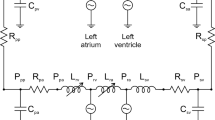Abstract
A lumped parameter model of the sub-system of left ventricle, aortic valve, systemic arteries, systemic capillaries and systemic veins was considered during systole. A model of aortic valve dynamics based solely on geometrical and kinematical consideration is defined. The model is described by two geometrical parameters of aortic valve and a few kinematical relationships. The proposed model mimics the incisures in the aortic flow and aortic pressure very well. We showed that the dicrotic notch could be explained by aortic valve closing in terms of a lumped parameter model, without a need for any wave reflection theory. According to the proposed model the effects of aortic valve dynamics on the aortic flow and pressure are mainly limited to the valve opening and closing periods. The model offers a new paradigm for defining a more realistic left ventricle model.
Similar content being viewed by others
References
Armentano R.L., Barra J.G., Levenson J., Simon A., Pichel R.H.: Arterial wall mechanics in conscious dogs. Assessment of viscous, inertial, and elastic moduli to characterize aortic wall behavior. Circ. Res. 76, 468–478 (1995)
Chemla D., Antony I., Zamani K., Nitenberg A.: Mean aortic pressure is the geometric mean of systolic and diastolic aortic pressure in resting humans. J. Appl. Physiol. 99, 2278–2284 (2005)
Garcia D., Barenbrug P., Pibarot P., Dekker A., van der Veen F.H., Maessen J.G., Dumesnil J.G., Durand L.G.: A ventricular-vascular coupling model in presence of aortic stenosis. Am. J. Physiol. Heart Circ. Physiol. 288, H1874–H1884 (1995)
Handke M., Heinrichs G., Beyersdorf F., Olschewski M., Bode C., Geibel A.: In vivo analysis of aortic valve dynamics by transesophageal three-dimensional echocardiography with high temporal resolution. J. Thorac. Cardiovasc. Surg. 125, 1412–1419 (2003)
Higashidate M., Tamiya K., Beppu T., Imai Y.: Regulation of the aortic valve opening in vivo dynamic measurement of aortic valve orifice area. J. Thorac. Cardiovasc. Surg. 110, 496–503 (1995)
Kass D.A., Beyar R., Lankford E., Heard M., Maughan W.L., Sagawa K.: Influence of contractile state on curvilinearity of in situ end-systolic pressure-volume relations. Circulation 79, 167–178 (1989)
Kass D.A., Maughan W.L.: From “Emax” to pressure-volume relations: a broader view. Circulation 78, 1203–1212 (1988)
Lewis J.F., Quinones M.A.: Pulsed Doppler echocardiographic determination of stroke volume. Circulation 70, 425–431 (1984)
Raff G.L., Glantz S.A.: Volume loading slows left ventricular isovolumic relaxation rate. Evidence of load-dependent relaxation in the intact dog heart. Circ. Res. 48, 813–824 (1981)
Safar M.E., Laurent P.: Pulse pressure and arterial stiffness in rats: comparison with humans. Am. J. Physiol. Heart Circ. Physiol. 285, H1363–H1369 (2003)
Sagawa K., Suga H., Shoukas A.A., Bakalar K.M.: End-systolic pressure-volume ratio: a new index of ventricular contractility. Am. J. Cardiol. 40, 748–753 (1976)
Segers P., Stergiopulos N., Westerhof N.: Relation of effective arterial elastance to arterial system properties. Am. J. Physiol. Heart Circ. Physiol. 282, H1041–H1046 (2002)
Stergiopulos N., Meister J.J., Westerhof N.: Determinants of stroke volume and systolic and diastolic aortic pressure. Am. J. Physiol. Heart Circ. Physiol. 270, H2050–H2059 (1996)
Suga H., Sagawa K.: Instantaneous pressure-volume relationships and their ratio in the excised, supported canine left ventricle. Circ. Res. 35, 117–126 (1974)
Suga H., Sagawa K., Shoukas A.A.: Load independence of the instantaneous pressure-volume ratio of the canine left ventricle and effects of epinephrine and heart rate on the ratio. Circ. Res. 32, 314–322 (1973)
Teichholz L.E., Kreulen T., Herman M.V., Gorlin R.: Problems in echocardiographic volume determination: Echocardiographic-angiographic correlations in the presence or absence of asynergy. Am. J. Cardiol. 37, 7–12 (1976)
Thomas J.D., Zhou J., Greenberg N., Bibawy G., McCarthy P.M., Vandervoort P.M.: Physical and physiological determinants of pulmonary venous flow: numerical analysis. Am. J. Physiol. Heart Circ. Physiol. 272, H2453–H2465 (1997)
Author information
Authors and Affiliations
Corresponding author
Rights and permissions
About this article
Cite this article
Virag, Z., Lulić, F. Modeling of aortic valve dynamics in a lumped parameter model of left ventricular-arterial coupling. Ann. Univ. Ferrara 54, 335–347 (2008). https://doi.org/10.1007/s11565-008-0051-3
Received:
Accepted:
Published:
Issue Date:
DOI: https://doi.org/10.1007/s11565-008-0051-3




